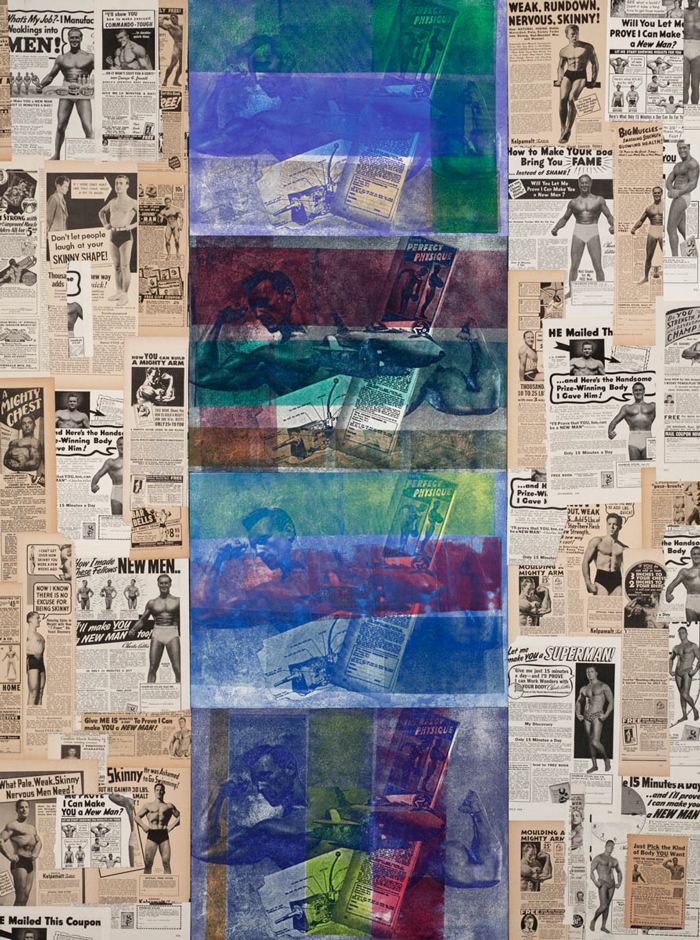From KOLAJ #15
Editorial: Layers of History
Ric Kasini Kadour reflects on the on the life and death of collage materials.
If I may talk about myself for a moment, one of the favourite things I ever made was Emergency Box Painting. A firm paper lid slid out of a small wood box and a sculpture of cut painting pieces rose up as a resurrection. I made it “for those times you are experiencing the death of painting.” I made it because I think all the talk about the Death of Painting, which has been going on since the beginning of the 20th century, is kind of stupid and Emergency Box Painting was a way of poking fun at curators and critics who like to pronounce art dead in the face of its everlasting life. All this is to say that I am a little embarrassed to speak now about the death of painting.
The collagist and their partner have never met and quite possibly lived years and generations apart. Most of the time, this unwitting, unwilling collaborator is nameless and lost to history.
One of the things that sets collage apart from painting is the fact that most collage (not all, and I will get to that) relies on a source material. More often than not, that source material was made by another artist or photographer or a graphic designer in a publishing house or magazine. The collagist and their partner have never met and quite possibly lived years and generations apart. Most of the time, this unwitting, unwilling collaborator is nameless and lost to history. How strange it must be to be a Life magazine advertisement maker or a camera-wielding anthropologist for National Geographic seeing their images recast in contemporary collage. The source material used in college was created for another purpose and lived a different life. Collage artists resurrect this material and give it new life.
This is fundamentally different than painting. Paint is a material that has no life before its use. It will quite possibly have no life after its use either. Its life is limited to the magical moment when an artist applies it to a surface and then it stands there, at attention, radiating colour, forever motionless. No one ever asks where that blue came from, what purpose it served before, who owns the rights to it. (Anish Kapoor caused a stir earlier this year by securing exclusive rights to Vantablack, a pigment is so black it absorbs 99.96 percent of light, but that’s a different story and a rare exception.) One could say that a painting has no history, that it is materially dead and any life it has lives more in the narrative about the artwork (who painted it, who saw it, who sold it, who owns it, etc.) than the material itself.
Painters give birth. Collage artists make and construct. That analytical emphasis is part of what attracts me to collage. Collagists facilitate a conversation with their material.
I don’t believe the tradition of painting is dead. I have always admired the physicality of painters. Hans Namuth recalled photographing Jackson Pollock at work in his studio, “His movements, slow at first, gradually became faster and more dance like as he flung black, white, and rust coloured paint onto the canvas.” The tactile nature of painting allows the artist to be physically intimate with the work. Painters give birth. Collage artists make and construct. That analytical emphasis is part of what attracts me to collage. Collagists facilitate a conversation with their material. This is as true for those collagists who are appropriating imagery from other sources as it is for those collagists who are generating their own sources. Here a different sort of alchemy takes place where the collagist is playing both roles and the dialogue taking place is one between the artist and themselves. And still, layers of history (even if that history is recent and personal) are embedded in the work.
Collage, on the other hand, takes dead material, a long forgotten Playboy spread or Ford motor car advert, and reintroduces this material into the contemporary visual dialogue. Collage gives the image new life. This is remarkable and unique to the genre. And while many collage artists give little consideration to their source material other than its aesthetic appeal, we routinely find that those artists in communion with their source material, those intimately aware of where it comes from and what role it played in its previous life, make collage that rise above the others.
PURCHASE KOLAJ #15 | SUBSCRIBE | FACEBOOK
image: Build A Perfect Physique #2 by Mitch Goldberg
36″x48″, collage with photo etchings, 2014
Courtesy of the artist

